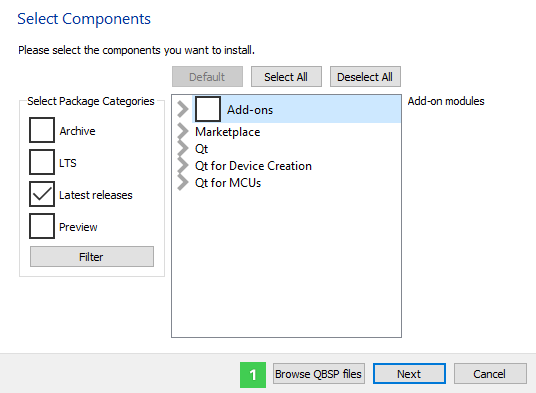C
Customizing QBSP content
Qt Board Support Package (QBSP) provides needed components for using Qt on an embedded device. QBSPs are installed using Qt Online Installer, either from online content or from a separately downloaded .qbsp file. QBSPs are available to commercial users.
When using Boot to Qt Software Stack, a QBSP contains a cross-compilation toolchain that is integrated into Qt Creator, and a device image that you can use to boot your device using Boot to Qt Software Stack. You can configure the QBSP to contain different content and change the way Qt Online Installer shows and installs the content.
QBSP Yocto recipes and classes
The base class to use for QBSP creation is qbsp.bbclass. Boot to Qt Software Stack is using it in meta-b2qt-embedded-qbsp.bb recipe, but you can also use it in your own recipe. The bbclass is available in meta-boot2qt layer which can also be used with other Yocto distros. qbsp.bbclass provides variables to control the creation of a QBSP. These are useful when a target hardware has not been integrated into Boot to Qt Software Stack, or there is a need to modify specific aspects of a package.
| QBSP variable | Purpose | Usual value in Boot to Qt |
|---|---|---|
QBSP_SDK_TASK | Task for creating the external SDK included in the QBSP. | meta-toolchain-b2qt-embedded-qt6-sdk |
QBSP_IMAGE_TASK | Task for creating the device image included in the QBSP. | b2qt-embedded-qt6-image |
QBSP_IMAGE_CONTENT | List of files and directories that are packaged as part of the QBSP device image. | ${IMAGE_LINK_NAME}.${DEPLOY_CONF_IMAGE_TYPE} ${IMAGE_LINK_NAME}.conf ${QBSP_README} |
QBSP_SDK | Output name used in the do_populate_sdk toolchain build, same as ${TOOLCHAIN_OUTPUTNAME}. | ${DISTRO}-${SDKMACHINE}-${QBSP_SDK_TASK}-${MACHINE} |
QBSP_NAME | Base name for the QBSP, visible in the installer description. | Boot2Qt ${QT_VERSION} |
QBSP_INSTALLER_COMPONENT | Unique component name. This string determines where in the installer tree the component is placed in relation to other components. Names must not contain : or - characters as these are reserved for Qt Installer Framework. With the default value, the tree is constructed as follows:Qt for Embedded Linux
└ Boot to Qt Software Stack ${QT_VERSION}
└ ${DEPLOY_CONF_NAME} | embedded.b2qt.${QT_VERSION}.${MACHINE} |
DEPLOY_CONF_NAME | Descriptive name for the target machine. Defaults to ${MACHINE}. | [device vendor] [device model] |
DEPLOY_CONF_IMAGE_TYPE | Image type for IMAGE_LINK_NAME, such as img, wic or wic.xz. | wic.xz |
QBSP_INSTALL_PATH | Location under the Qt SDK where the files are installed. | /${QT_VERSION}/Boot2Qt/${MACHINE} |
QBSP_LICENSE_FILE | If a separate license agreement needs to be accepted before installation, this variable defines the file that contains the license text. | Depends on ${MACHINE} |
QBSP_LICENSE_NAME | Descriptive name for the license shown in the installer. | Depends on ${MACHINE} |
QBSP_README | A file containing installation instructions for the device. See qbsp-readme.bb recipe for more details. | README |
meta-b2qt-embedded-qbsp is the meta-recipe that builds the QBSPs with Boot to Qt image and toolchain. It inherits qbsp.bbclass and sets dependencies to the selected image and toolchain recipes. In addition, it sets variables to control the install locations and how the content is displayed in the Qt Online Installer.
Example QBSP recipe
The following is an example recipe that builds a QBSP from your own image after Qt has been included in it.
inherit qbsp
# Name used in the Qt Online Installer
QBSP_NAME = "Qt ${QT_VERSION}"
# Pretty names for the devices
DEPLOY_CONF_NAME:raspberrypi4-64 = "Raspberry Pi 4 (64-bit)"
# Define the location of the QBSP component inside the online installer tree
BSP_INSTALLER_COMPONENT = "embedded.rpi.${@d.getVar('QT_VERSION').replace('.','')}.${@d.getVar('MACHINE').replace('-','')}"
# Path where qbsp content is installed under the SDK installation root
QBSP_INSTALL_PATH = "/${QT_VERSION}/rpi/${MACHINE}"
# Recipes that are used for image and SDK
QBSP_SDK_TASK = "rpi-qt-image"
QBSP_IMAGE_TASK = "rpi-qt-image"
# Output files from image build (DEPLOY_DIR_IMAGE)
# and sdk build (TOOLCHAIN_OUTPUTNAME)
QBSP_IMAGE_CONTENT = "${DEPLOY_DIR_IMAGE}"
QBSP_SDK = "${SDK_NAME}-toolchain-${SDK_VERSION}"Verifying QBSP build
After you have built the QBSP file, you can verify it with Qt Online Installer. If the QBSP file was successfully created, you can load it into the installer and install the QBSP's content.
Verify your QBSP build as follows:
- Open Qt Online Installer.
- Follow the instructions in the wizard until you reach the Select Components page.
- Select Browse QBSP Files (1).
- Browse to your QBSP file and select Open. Content of your QBSP file appears in the tree view.
- Select the component(s) to be installed and follow instructions in the wizard.

You should be able to find the installed QBSP content under your <Qt installation directory>.
Available under certain Qt licenses.
Find out more.

